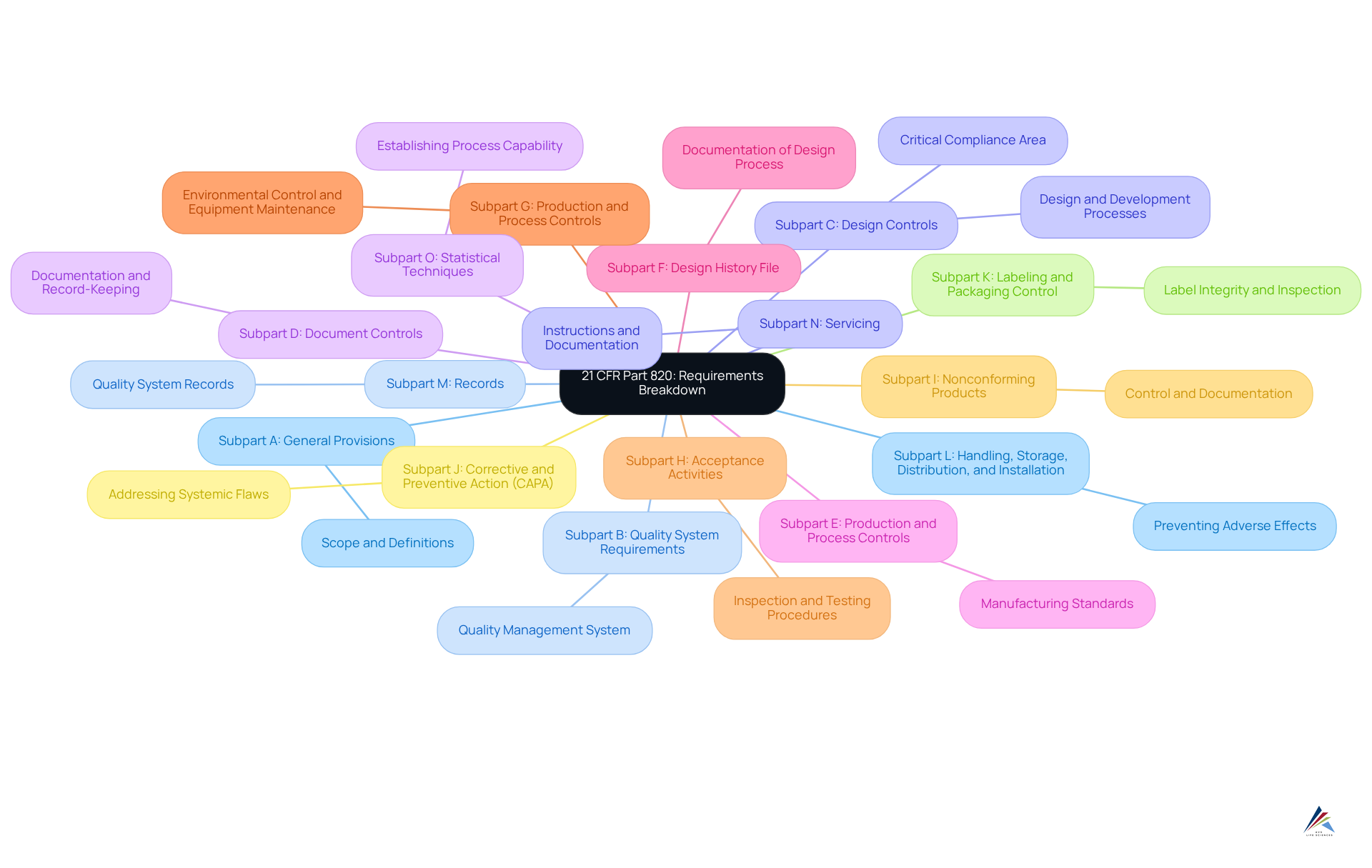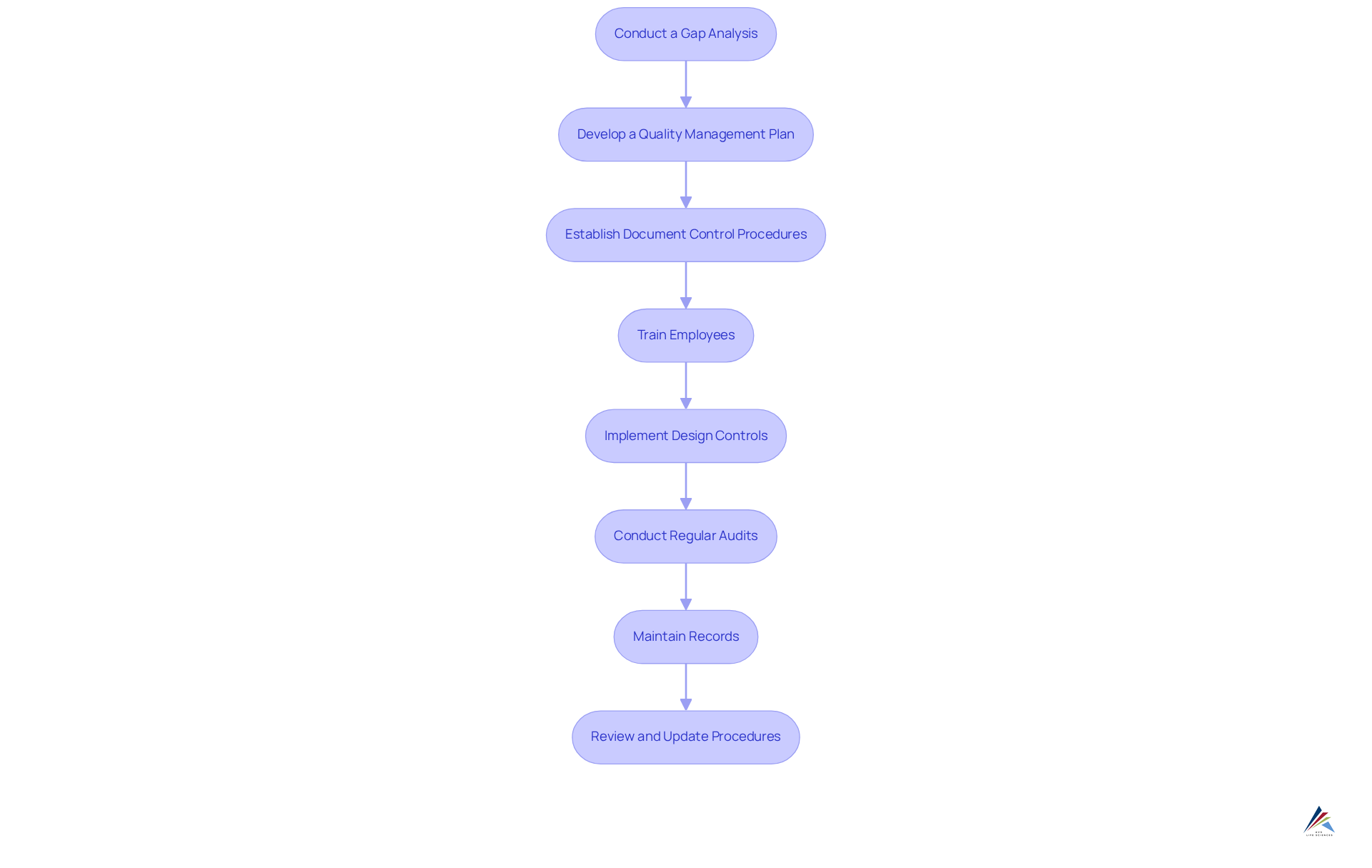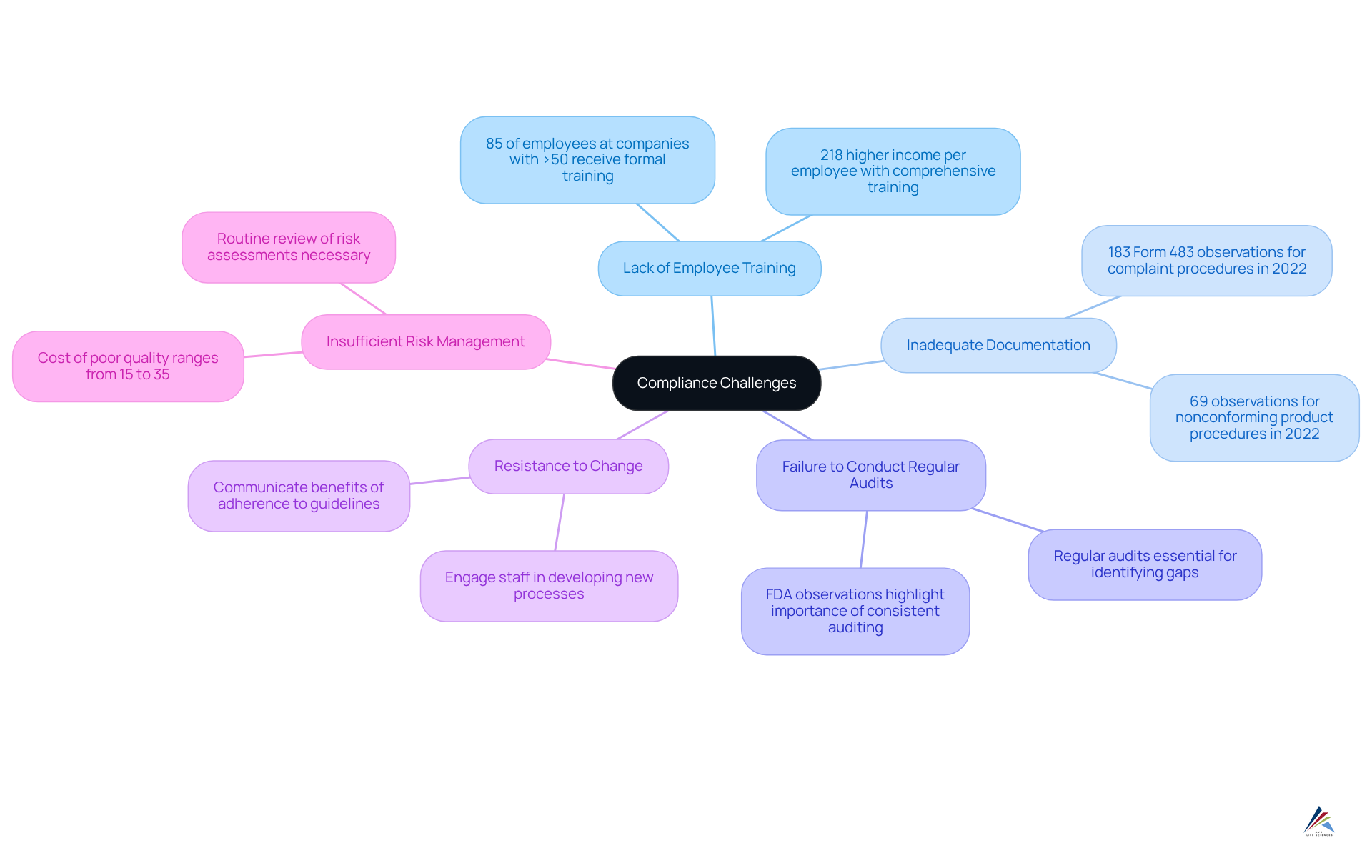21cfr820: Essential Steps for Compliance Success in Pharma

Overview
Achieving compliance success in the pharmaceutical sector, particularly under 21 CFR Part 820, necessitates a thorough understanding of the Quality System Regulation (QSR) and the implementation of structured quality management practices. Adhering to this regulation is not merely a legal obligation; it is a critical strategy that ensures product safety and efficacy while safeguarding organizations against legal repercussions and bolstering their market reputation.
Key components of an effective compliance strategy include:
- Comprehensive training
- Meticulous documentation
- Regular audits
These elements are indispensable for fostering a culture of quality and compliance within organizations. By prioritizing these practices, companies can navigate the complexities of regulatory requirements and position themselves as leaders in the industry.
Introduction
Understanding the intricacies of 21 CFR Part 820 is crucial for any organization involved in the medical device industry. This regulation serves as the backbone of quality management systems. By adhering to its stringent requirements, companies can enhance product safety and efficacy, protect themselves from legal repercussions, and bolster their market reputation.
However, as the regulatory landscape evolves—especially with the integration of ISO 13485:2016 on the horizon—organizations face significant compliance challenges. How can they effectively navigate these complexities and ensure they meet these critical standards? Engaging with compliance solutions is essential for success.
Understand 21 CFR Part 820: Key Concepts and Importance
21cfr820, known as the Quality System Regulation (QSR), delineates the criteria for management systems (QMS) for medical device producers. This regulation is pivotal in ensuring that devices are consistently produced and controlled in accordance with quality standards. Compliance with this regulation is essential, as it helps prevent defects and guarantees that products are safe and effective for consumers. Understanding the is vital for any organization involved in the design, manufacture, packaging, labeling, storage, installation, and servicing of medical devices. This regulation not only upholds high-quality standards but also safeguards companies from potential legal issues and bolsters their reputation in the market.
Design controls are mandatory solely for specific Class I devices outlined in § 820.30(a)(2) and for all Class II and Class III devices, marking a critical detail regarding the scope of 21cfr820.
The forthcoming changes to this regulation, effective February 2026, will integrate ISO 13485:2016 as the U.S. QMS foundation, heightening the demand for effective compliance solutions and underscoring the evolving regulatory landscape.
Furthermore, nearly 50% of all FDA Form 483 observations are associated with inadequate or inconsistent Corrective and Preventive Action (CAPA) processes, highlighting the pressing need for structured quality management practices.
Industry leaders stress the significance of these regulations for product safety. Regulatory experts assert that compliance with 21cfr820 is crucial for ensuring the safety and efficacy of medical devices.
In conclusion, grasping and implementing the key concepts of 21cfr820 is indispensable for any organization operating within the medical device industry. It not only enhances product safety and effectiveness but also positions companies for success in a highly regulated environment.

Explore the Subparts of 21 CFR Part 820: Requirements Breakdown
The regulations outlined in are meticulously organized into 15 subparts, each targeting critical elements of management essential for compliance in the medical device sector. Here’s an overview of some key subparts:
- Subpart A: General Provisions - This section delineates the scope and definitions relevant to the regulation, establishing a foundational understanding for manufacturers.
- Subpart B: Quality System Requirements - It articulates the overarching requirements for a quality management system, ensuring that all processes align with regulatory expectations.
- Subpart C: Design Controls - This subpart details the requirements for design and development processes, emphasizing the necessity of ensuring product safety and effectiveness through rigorous controls. Notably, deficiencies in design controls ranked first among 21 Warning Letters issued in 2024, underscoring the critical nature of compliance in this area.
- Subpart D: Document Controls - It highlights the significance of robust documentation and record-keeping practices, which are vital for maintaining compliance and facilitating audits. The FDA has issued numerous citations under this subpart, further emphasizing the importance of adherence.
- Subpart E: Production and Process Controls - This section addresses the controls necessary during production to uphold standards, ensuring that manufacturing processes do not compromise product integrity.
- Subpart F: Design History File - Manufacturers are mandated to maintain a design history file for each device, documenting the design process and decisions made throughout development.
Each subpart encompasses specific requirements that manufacturers must adhere to, making it imperative to understand these regulations for effective compliance and successful implementation of quality management practices. As the FDA indicates, 21cfr820 governs 'every aspect of human-use devices, including their design, manufacture, packaging, labeling, storage, installation, and maintenance.' Moreover, with the impending transition to the new Quality Management System Regulation (QMSR) effective February 2, 2026, oversight officers must remain vigilant regarding these evolving requirements to avert potential citations, recalls, or fines.

Implement Compliance Strategies: Step-by-Step Actions for Success
To effectively implement compliance strategies for 21 CFR Part 820, organizations must adhere to these essential steps:
- Conduct a Gap Analysis: Begin by assessing your current management system against the requirements of 21cfr820. This critical analysis identifies areas needing improvement, pinpointing discrepancies that could impact regulatory adherence and product quality. Categorize these discrepancies by their impact to prioritize corrective actions effectively.
- Develop a Quality Management Plan: Formulate a comprehensive plan that details how your organization will meet the regulation's requirements. This plan should include specific timelines and assign responsibilities, ensuring accountability throughout the process.
- Establish Document Control Procedures: Implement robust procedures for the creation, review, and maintenance of documents. This step is crucial for fulfilling the stringent documentation criteria specified in 21cfr820, particularly Subpart D, which emphasizes efficient document management throughout the product lifecycle.
- Train employees: Provide thorough training on the and the specific requirements of 21cfr820 relevant to their roles. Effective training programs significantly enhance adherence success, as informed employees are better equipped to follow regulatory standards. Statistics demonstrate that organizations with comprehensive training experience marked improvements in regulatory outcomes.
- Implement Design Controls: Ensure that design controls are established for all products, incorporating design verification and validation processes. This step is essential for compliance with Subpart C, which outlines the required procedures for ensuring that devices are designed according to their specifications.
- Conduct Regular Audits: Arrange internal reviews to assess adherence to the management system. These audits should aim to identify areas for improvement and ensure that the system remains effective and aligned with regulatory requirements. View audits as beneficial activities rather than mere regulatory checks to foster a culture of continuous enhancement.
- Maintain Records: Keep meticulous records of all processes, changes, and audits. This documentation is vital for demonstrating adherence during inspections, as 21cfr820 mandates that records be retained for a minimum of two years from the date of release for commercial distribution.
- Review and Update Procedures: Regularly assess and modify your management system to adapt to changes in regulations or company operations. This proactive strategy not only upholds compliance but also ensures that your organization is prepared for any regulatory shifts.
By diligently following these steps, organizations can establish a strong foundation for alignment with 21cfr820, ultimately enhancing product quality and regulatory adherence.

Overcome Compliance Challenges: Troubleshooting Common Issues
Organizations often encounter significant challenges when striving to comply with 21cfr820. Below are some prevalent issues, accompanied by effective troubleshooting tips:
- Lack of Employee Training: A major obstacle to compliance is insufficient employee training. Regular training sessions are crucial to underscore the importance of adhering to regulations. Statistics reveal that 85% of employees at companies with more than 50 employees receive formal training, highlighting the necessity of structured learning programs. Additionally, organizations with comprehensive employee training programs report a 218% higher income per employee, emphasizing the financial advantages of effective training and documentation practices.
- Inadequate Documentation: Numerous organizations struggle with maintaining accurate records, which is vital for compliance. Implementing a robust document control system ensures that all records remain accurate, accessible, and up-to-date. Notably, the FDA issued 183 Form 483 observations related to complaint procedures in 2022, along with 69 observations concerning nonconforming product procedures, underscoring the critical need for meticulous documentation practices.
- Failure to Conduct Regular Audits: Conducting regular audits is essential for identifying gaps in adherence. Organizations should schedule audits at least annually and promptly address any findings. The FDA's observations highlight the importance of consistent auditing practices to ensure compliance and mitigate risks.
- Resistance to Change: Employees may resist alterations to established processes. To foster support, it is vital to clearly communicate the and engage staff in the development of new processes. Involving employees in the change process can significantly enhance their commitment to regulatory initiatives.
- Insufficient Risk Management: A proactive risk management strategy is crucial for identifying and mitigating potential regulatory risks. Organizations should routinely review and update risk assessments to adapt to the evolving regulatory landscape. The cost of poor quality, including rework and recalls, can range from 15% to 35% of total business costs in regulated industries, making effective risk management a financial necessity.
By addressing these common challenges, organizations can substantially improve their compliance efforts and ensure adherence to 21cfr820.

Conclusion
Understanding and adhering to 21 CFR Part 820 is not just important; it is essential for any organization operating within the medical device industry. This regulation provides a foundational framework that guarantees products are manufactured and controlled in accordance with stringent quality standards. By prioritizing compliance, companies can significantly enhance product safety and efficacy, while simultaneously protecting their reputation and mitigating potential legal risks.
The article delineates the critical components of 21 CFR Part 820, encompassing its key concepts, subparts, and effective compliance strategies. It emphasizes the necessity of thorough training, robust documentation, and regular audits, while also addressing prevalent challenges organizations encounter, such as inadequate employee training and insufficient risk management. By implementing these strategies, companies can adeptly navigate the complexities of compliance and position themselves for success in a highly regulated environment.
Ultimately, the significance of 21 CFR Part 820 transcends mere regulatory adherence; it represents a steadfast commitment to quality and safety within the pharmaceutical industry. Organizations are urged to proactively embrace these compliance measures, ensuring they not only meet regulatory standards but also cultivate a culture of continuous improvement and excellence in product quality.
Frequently Asked Questions
What is 21 CFR Part 820?
21 CFR Part 820, known as the Quality System Regulation (QSR), outlines the criteria for quality management systems (QMS) for medical device producers to ensure that devices are consistently produced and controlled in accordance with quality standards.
Why is compliance with 21 CFR Part 820 important?
Compliance with 21 CFR Part 820 is essential as it helps prevent defects, guarantees that products are safe and effective for consumers, safeguards companies from potential legal issues, and enhances their reputation in the market.
Who needs to understand the key concepts of 21 CFR Part 820?
Any organization involved in the design, manufacture, packaging, labeling, storage, installation, and servicing of medical devices needs to understand the key concepts of 21 CFR Part 820.
What are design controls, and who are they mandatory for?
Design controls are mandatory for specific Class I devices outlined in § 820.30(a)(2) and for all Class II and Class III devices, which is a critical aspect of the scope of 21 CFR Part 820.
What changes are expected in 21 CFR Part 820 in February 2026?
In February 2026, 21 CFR Part 820 will integrate ISO 13485:2016 as the U.S. QMS foundation, increasing the demand for effective compliance solutions and reflecting the evolving regulatory landscape.
What is the significance of Corrective and Preventive Action (CAPA) processes in relation to 21 CFR Part 820?
Nearly 50% of all FDA Form 483 observations are linked to inadequate or inconsistent CAPA processes, highlighting the need for structured quality management practices to ensure compliance with 21 CFR Part 820.
How do industry leaders view the regulations of 21 CFR Part 820?
Industry leaders emphasize the significance of 21 CFR Part 820 regulations for product safety, asserting that compliance is crucial for ensuring the safety and efficacy of medical devices.
What overall impact does understanding 21 CFR Part 820 have on organizations in the medical device industry?
Grasping and implementing the key concepts of 21 CFR Part 820 is indispensable for organizations in the medical device industry, enhancing product safety and effectiveness while positioning companies for success in a highly regulated environment.
